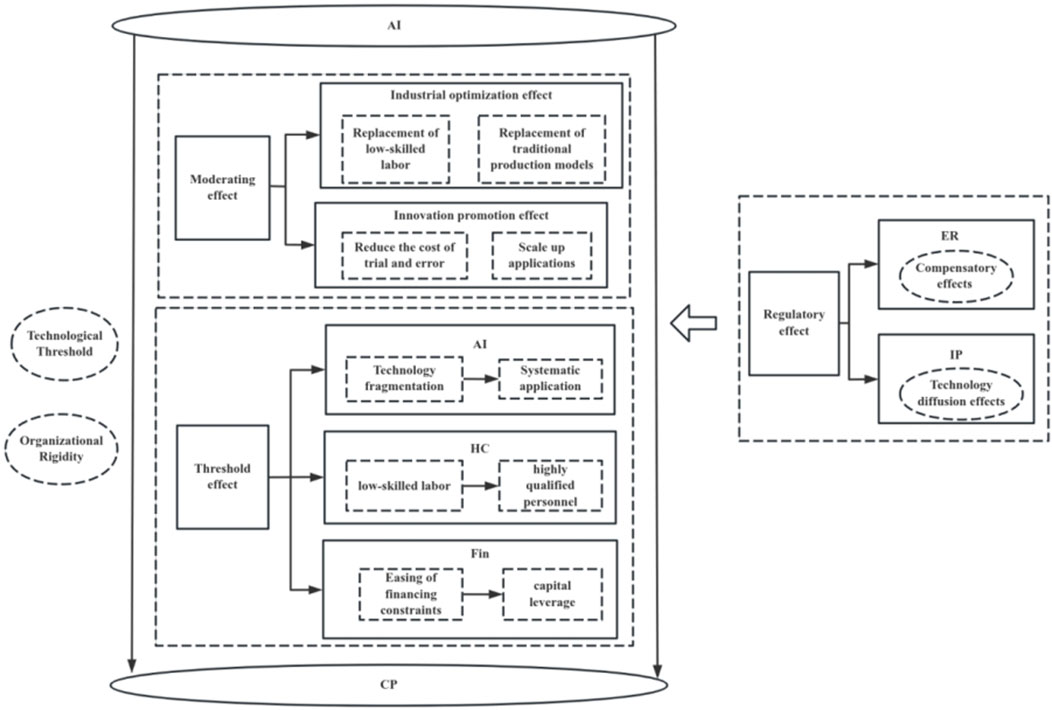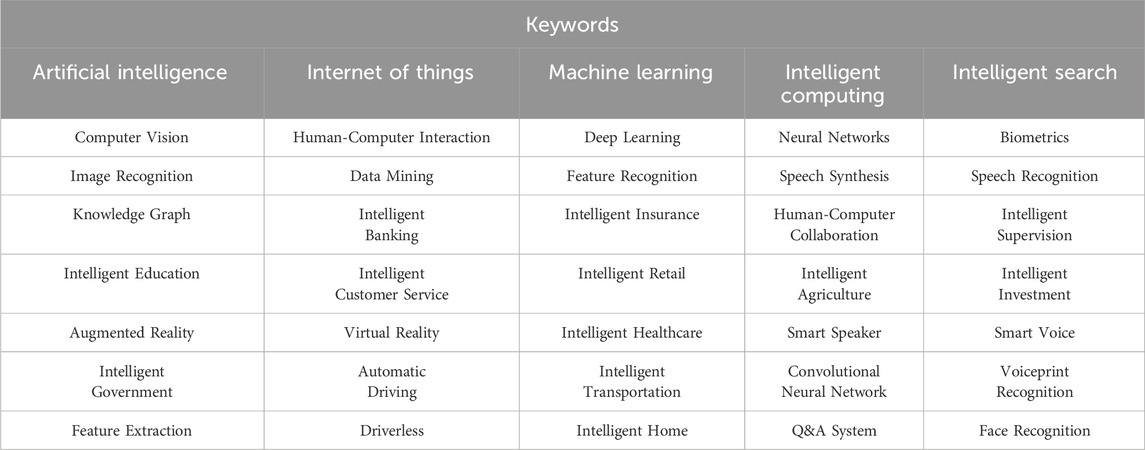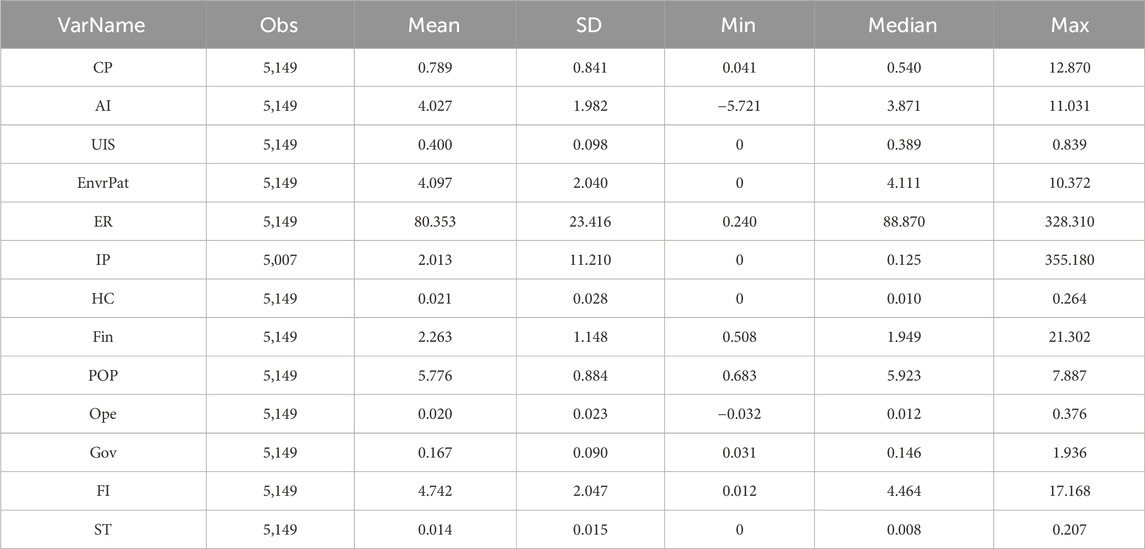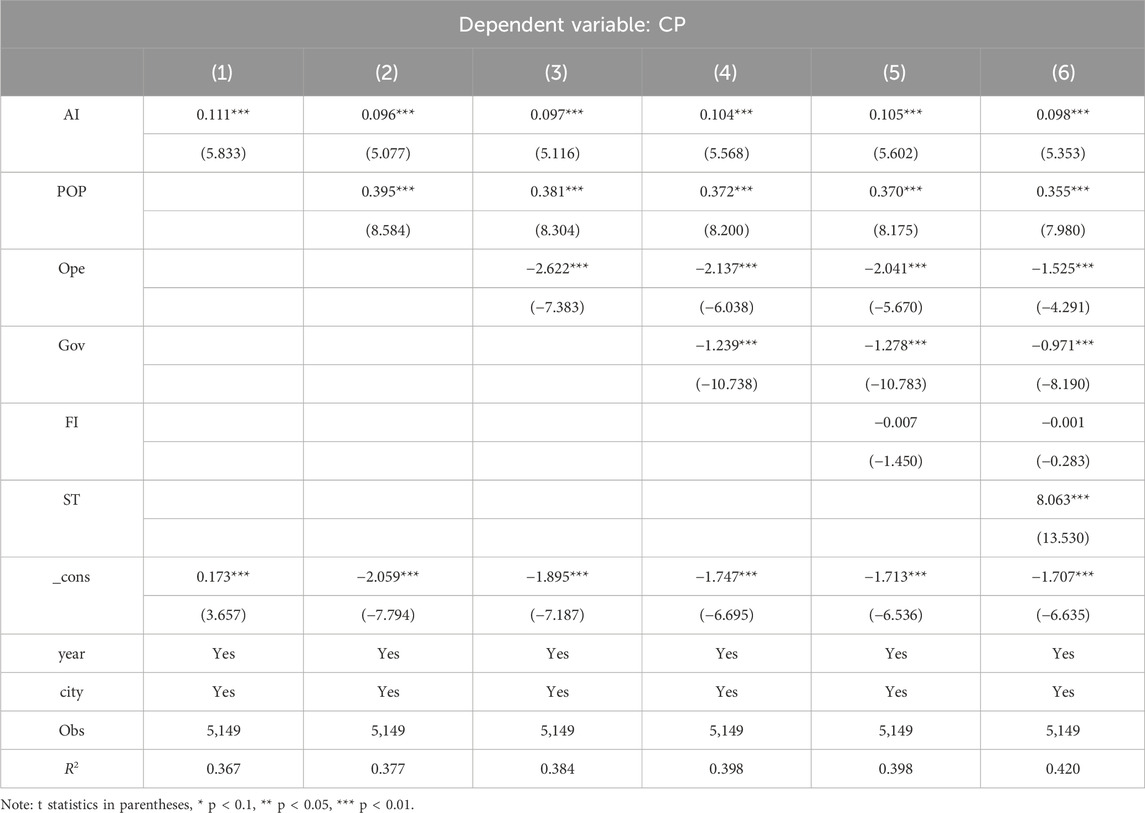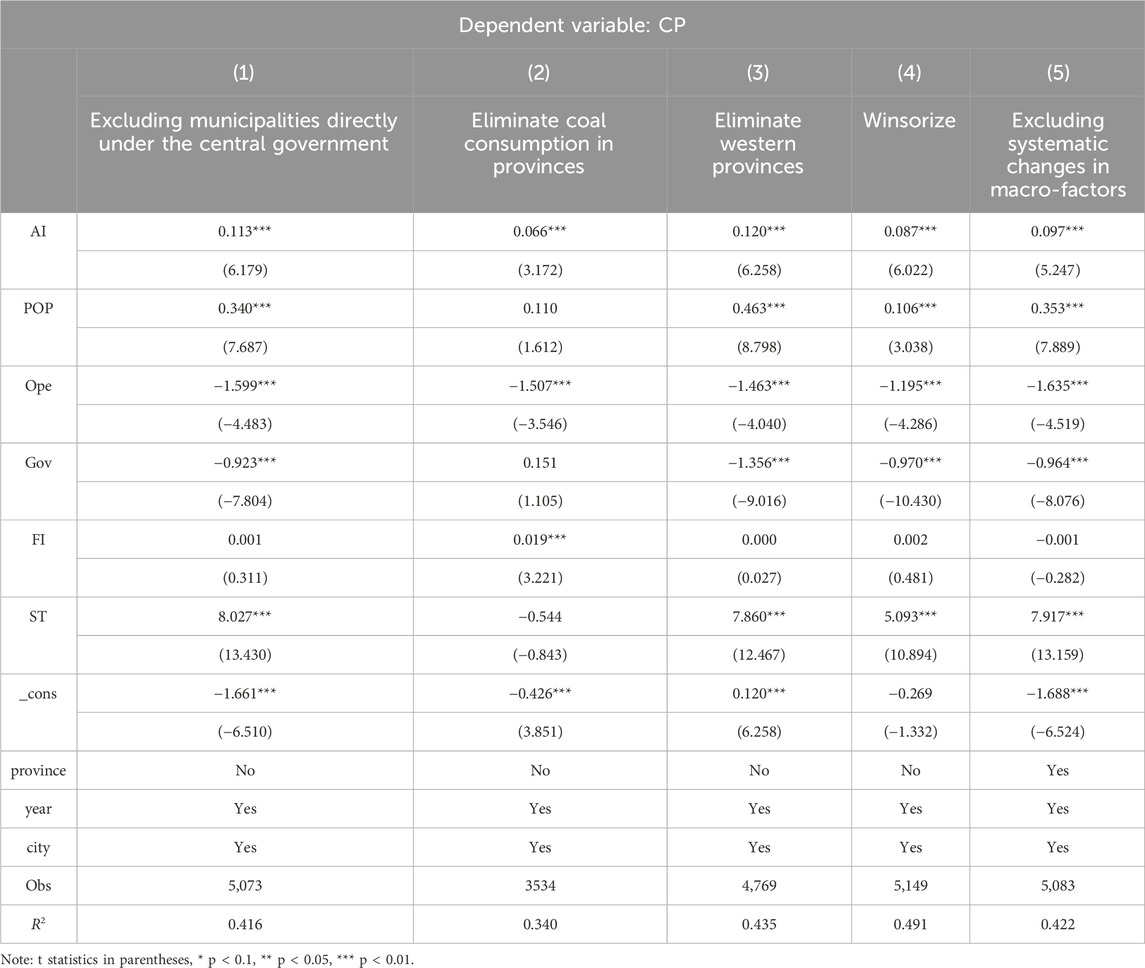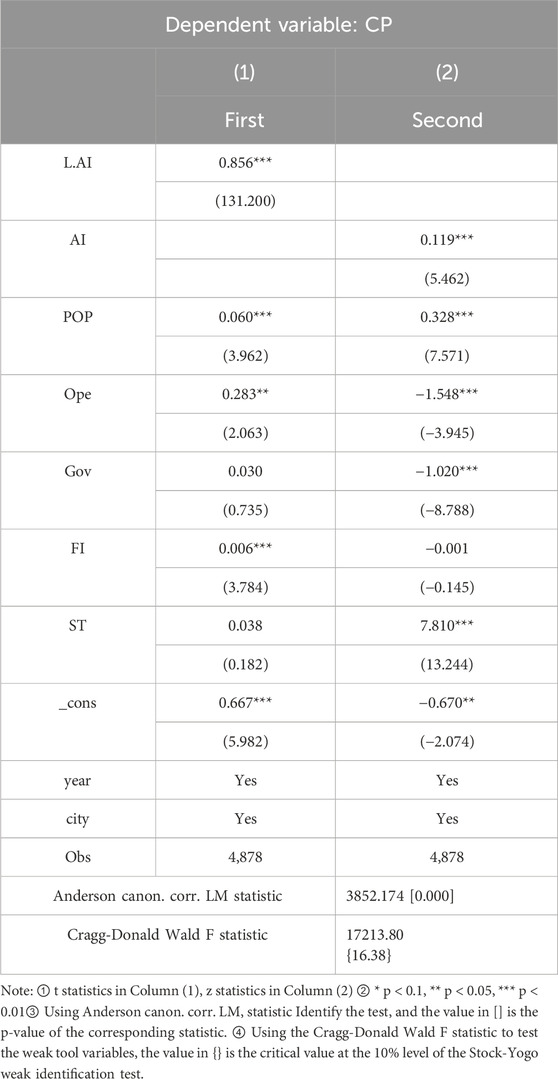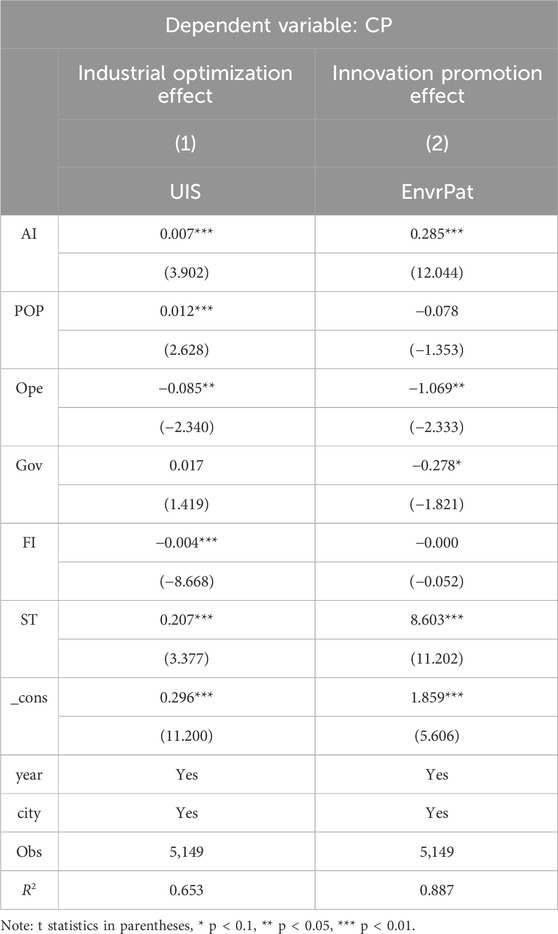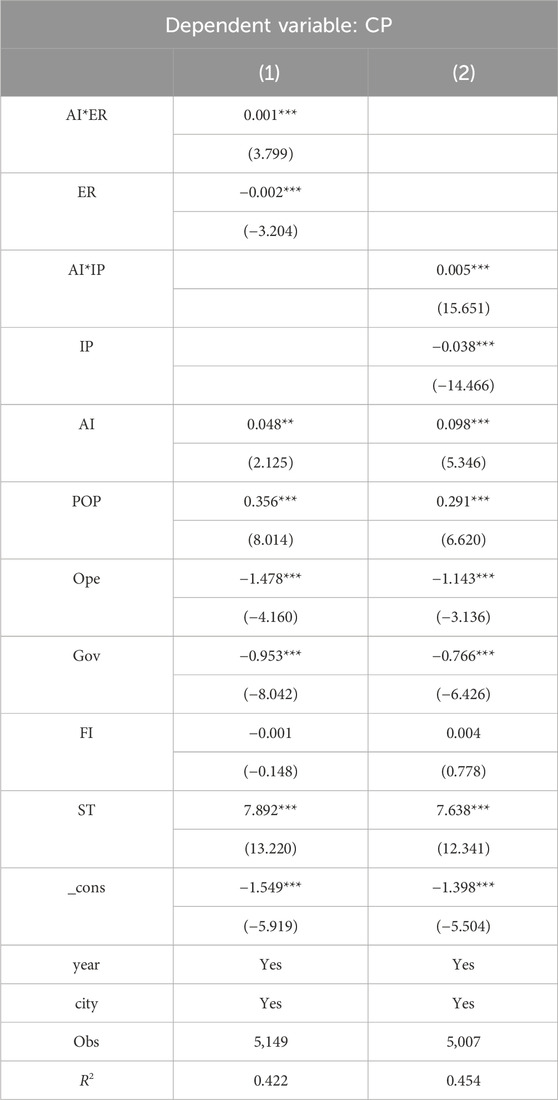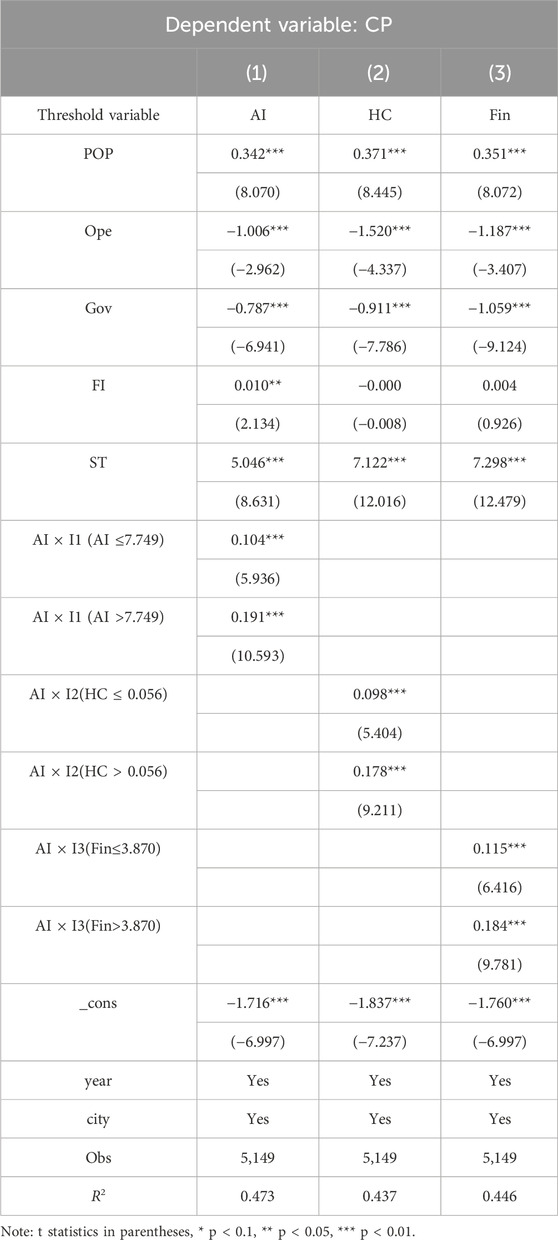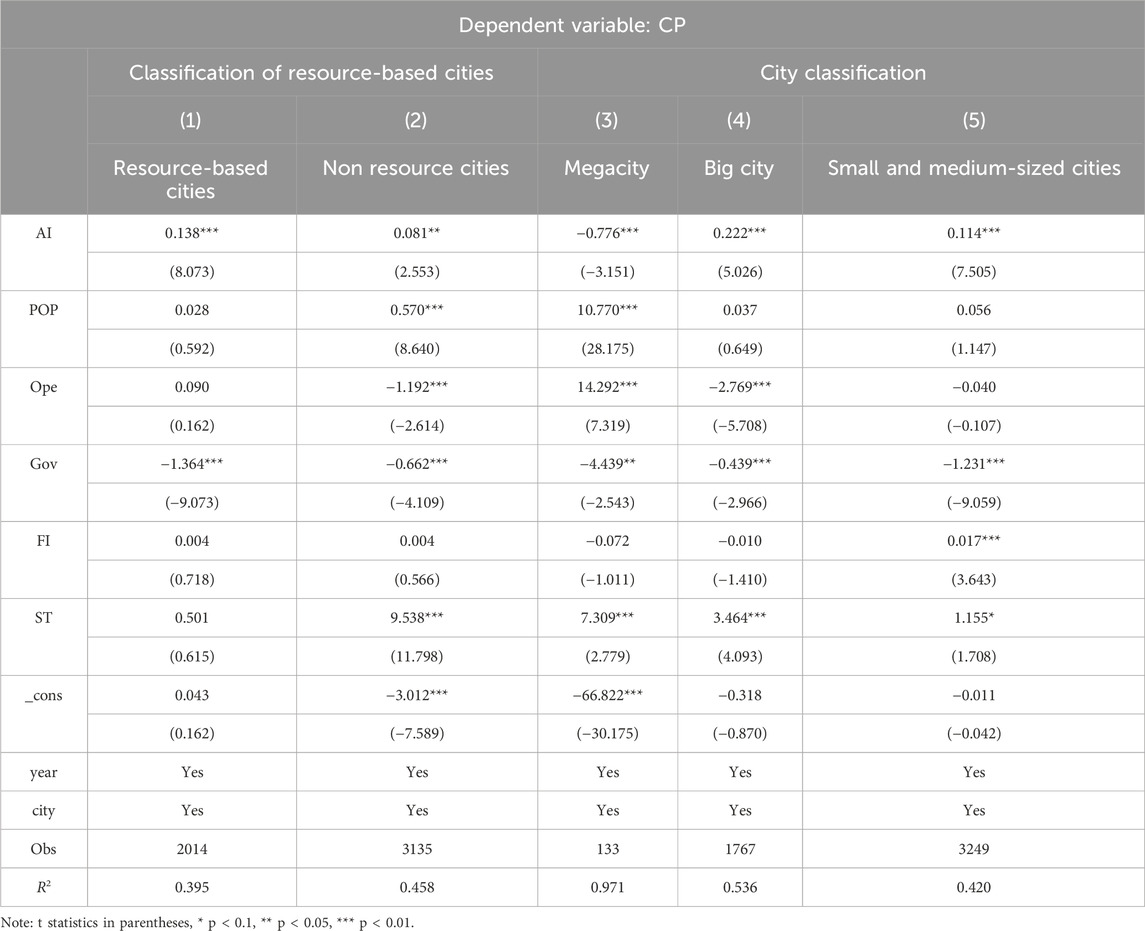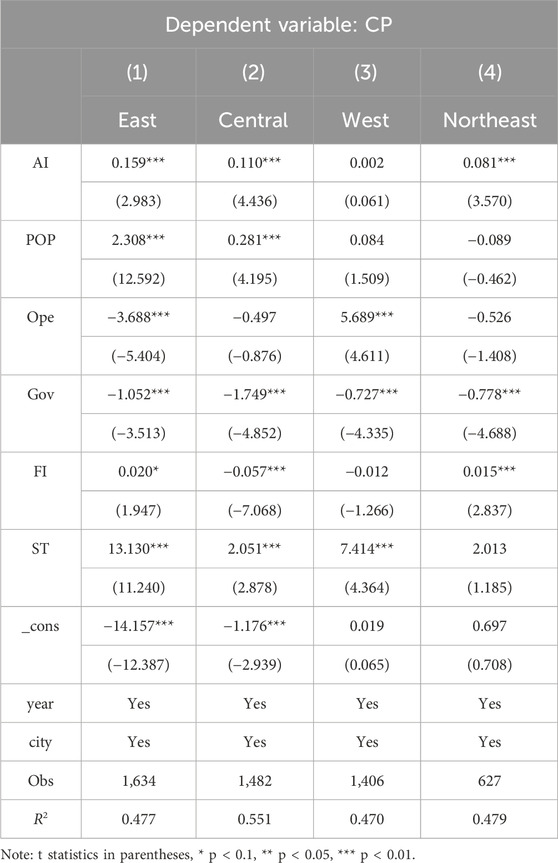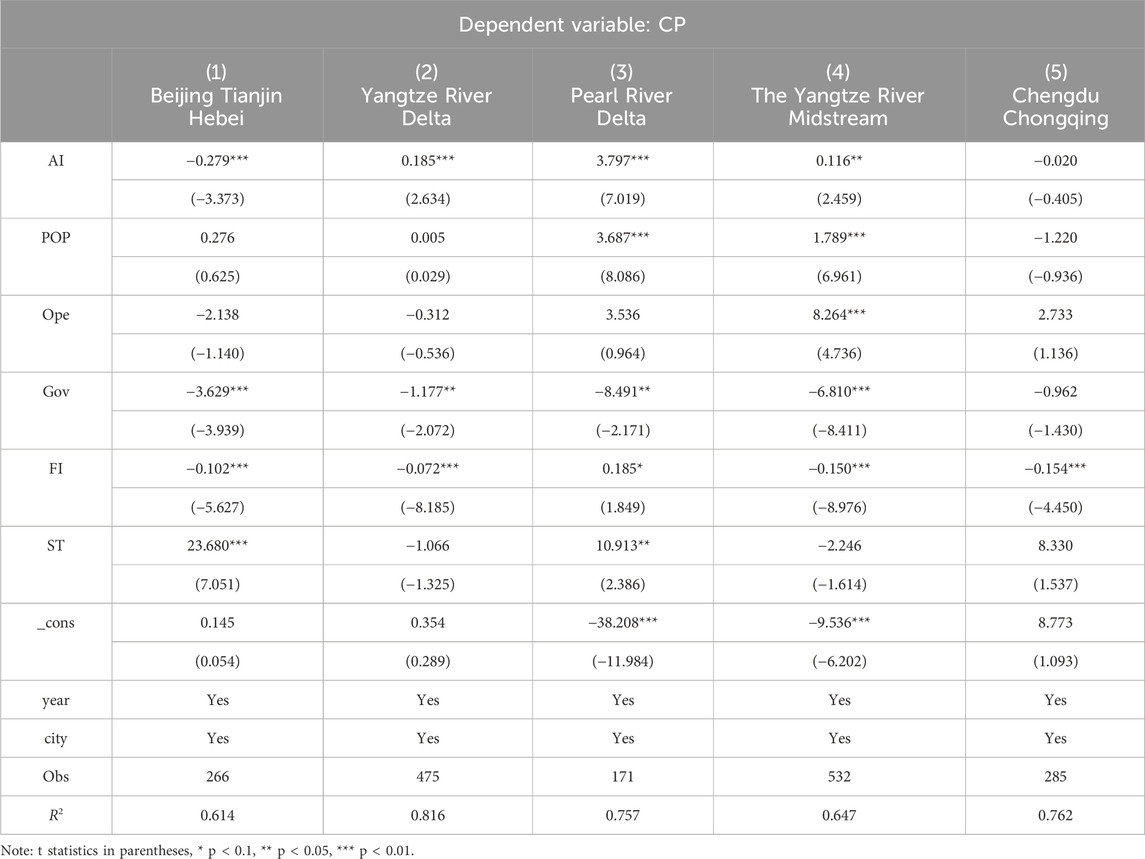- School of Economics and Management, Nanjing Tech University, Nanjing, China
Artificial intelligence (AI) provides novel technological pathways and research perspectives to mitigate global carbon emissions. This study empirically examines the impact of AI on carbon productivity utilizing panel data from 286 prefecture-level cities in China, covering the period from 2003 to 2021. The results indicate that AI enhances urban carbon productivity (CP). Mechanism analysis reveals that AI indirectly improves carbon productivity via industrial optimization and innovation promotion impacts, with environmental regulation (ER) and internet penetration (IP) rates serving as positive moderating factors in this process. A subsequent study reveals that the influences of AI, human capital (HC), and financial development (Fin) on carbon productivity display threshold effects marked by escalating marginal returns. Heterogeneity research indicates that the impact of AI on carbon production differs markedly across various resource endowments, city sizes, regions, and urban agglomerations. This study’s conclusions provide novel theoretical frameworks for implementing AI technology in carbon emission reduction and furnish critical insights for advancing low-carbon transitions.
1 Introduction
Since the onset of the Fourth Industrial Revolution, the large-scale development and use of fossil energy has driven the infrastructure of the information industry to take root, contributing to the rapid growth of the global economy (Xi and Shao, 2025; Shi et al., 2024). Nonetheless, this affluence has incurred considerable environmental expenses. The significant rise in atmospheric carbon dioxide emissions has resulted in various environmental challenges, including increased extreme weather occurrences, elevated sea levels, and exacerbated urban heat island effects (Wei et al., 2025; Nordhaus, 1991), presenting a considerable threat to human existence and progress. Although sustained GDP growth is perceived as an indicator of national wealth, the increase in carbon emissions has emerged as the foremost impediment to global sustainable development, rendering the equilibrium between GDP growth and carbon reduction a global issue. Carbon productivity, a fundamental statistic for evaluating the economic value produced per unit of carbon emissions, was introduced by Kaya and Yokobori in 1997. Amid this contradictory context, this statistic has progressively emerged as a focal point of global scrutiny. Amid escalating climate change, enhancing carbon productivity has become a pivotal problem of collective concern among nations (Dong et al., 2025). As the preeminent global energy user and carbon emitter, China must rapidly address and reconcile this issue. The 2024 National Air Quality Report indicates that the yearly average PM2.5 concentration in 339 prefecture-level and higher cities in China attained 22 μg/m3, far beyond the World Health Organization’s recommended safe limit of 5 μg/m3. This pollution-intensive, high-emission growth paradigm jeopardizes public health and presents significant obstacles to the sustainable development of China’s economy (Ma et al., 2024). Faced with this problem, the Chinese government formally pledged to the international community at the 75th United Nations General Assembly in 2020 to achieve peak carbon emissions by 2030 and to attain carbon neutrality by 2060 (Luo et al., 2022).
To effectively reduce emissions and enhance efficiency, identify the primary factors affecting carbon productivity, which is crucial for advancing climate actions and developing emission reduction policies in China (Auffhammer and Carson, 2008). Artificial intelligence (AI), a fundamental technology of the Fourth Industrial Revolution, injects new momentum into economic growth and exhibits considerable potential in energy management, industrial intelligence, and the research and development of green technologies (Zhou et al., 2024; Alruwaili and Mohamed, 2024; Liang et al., 2022). In the realm of global climate governance and carbon-neutral objectives, artificial intelligence is becoming an essential instrument for emission reduction and efficiency enhancement. Nonetheless, the dual nature of AI’s impact is becoming more apparent: it transforms conventional economic frameworks by optimizing energy distribution, improving renewable energy efficiency, and fostering green technology innovation, thereby creating opportunities for decoupling economic growth from carbon emissions (Gao et al., 2025; Tao, 2024). Conversely, its substantial energy consumption requirements for computational power may increase carbon footprints and potentially negate some benefits of emission reductions (Brevini, 2020). Achieving China’s “2030 carbon peak and 2060 carbon neutrality” goals necessitates a strategic focus on balancing the technological benefits of AI with its associated energy consumption challenges, while also exploring avenues to enhance carbon productivity. The potential of AI to enhance carbon productivity has garnered considerable attention; however, the systematic mechanisms and intrinsic relationships between AI and carbon productivity remain inadequately explained theoretically and empirically. Is AI an “accelerator” for enhancing carbon productivity or an “invisible enabler” of potential carbon risks? Understanding the mechanisms by which AI influences carbon productivity facilitates the realization of its technological benefits and offers a scientific foundation for China to achieve a balance between economic growth and carbon emissions. This study examines data from 286 prefecture-level cities in China spanning 2003 to 2021 to explore the correlation between artificial intelligence and carbon production.
The marginal contributions of this study are reflected in three aspects: first, it examines the influence of artificial intelligence (AI) levels on carbon productivity, offering empirical support for AI-facilitated low-carbon transformation; second, it investigates the mechanisms through which AI improves carbon productivity by optimizing industries and promoting innovation, while also elucidating the moderating roles of environmental regulation and internet penetration on AI’s impact; third, in contrast to the prevailing reliance on traditional linear panel regression models, this research employs a threshold model to uncover the nonlinear dynamics of “increasing marginal effects” of AI, human capital, and financial development on carbon productivity from a multidimensional perspective.
This study is structured as follows: Section 2 examines the relevant literature. Section 3 delineates the theoretical analysis and articulates the research hypotheses. Section 4 delineates the model architecture and the selection of variables. Section 5 presents the empirical findings. Section 6 further investigates threshold effects and heterogeneity. Section 7 ends the research and offers policy recommendations.
2 Literature review
2.1 Research on artificial intelligence
In recent years, artificial intelligence has emerged as the pivotal force driving global technological transformation, capturing significant attention across various industries.
However, research on measurement methodologies for artificial intelligence remains in its nascent stage, leading to diverse scholarly explorations of quantification approaches (Calabrese et al., 2023). Ding et al. (2023) developed a framework from an innovation perspective, constructing dimensions of supportiveness, vitality, and advantage, while Zhou et al. (2024) adopted a multidimensional approach considering environmental support capacity, technological innovation capability, and industrial competitiveness. Furthermore, proxy variable methods have become important supplementary research tools due to their data accessibility and representativeness.
The application of proxy variables such as industrial robot data to reflect artificial intelligence development levels has gained widespread usage (Graetz and Michaels, 2018; Fan et al., 2021; Yu et al., 2023). With the rapid advancement of big data and natural language processing technologies, textual analysis methods have gradually emerged, providing new perspectives and tools for measuring artificial intelligence levels.
Artificial intelligence levels can be measured through Python-based word frequency analysis extracting relevant keywords from corporate annual reports or policy documents (Chen and Jin, 2023), while the annual count of newly registered AI enterprises by region has also emerged as a novel research paradigm (Luo and Wang, 2025). Textual analysis methods can more directly capture the dynamic changes in artificial intelligence while avoiding the subjectivity inherent in indicator system construction and the limitations of proxy variable selection. Based on these considerations, this study also employs textual analysis methodology. The development of artificial intelligence technologies has profoundly influenced human production and daily life (Graetz and Michaels, 2018). With continuous advancements in global digital technologies including quantum computing and energy blockchain, scholars have increasingly focused on artificial intelligence’s impacts on environmental energy and economic systems. Artificial intelligence can predict and assess climate change trends, providing scientific foundations for climate governance (Shobanke et al., 2025). Moreover, AI algorithms have enhanced energy utilization efficiency and reduced operational costs through intelligent detection in electric vehicle thermal circulation systems (Li and Wen, 2025). In the economic domain, artificial intelligence technology has been widely applied to enterprise process innovation, generating annual total cost savings for businesses (Rammer et al., 2022). Simultaneously, artificial intelligence can reshape labor market structures through technological transformation, creating employment opportunities and reducing unemployment rates (Ma et al., 2022; Bachmann et al., 2024).
2.2 Research on carbon productivity
Since the proposal of the “dual carbon” goals, green and low-carbon development has become a focal issue attracting widespread attention across society. Current research on carbon productivity primarily concentrates on measurement methods and their influencing factors. Regarding measurement approaches, academia mainly adopts two types of metrics: single-factor and multi-factor methods. Kaya and Yokobori (1997) first proposed the single-factor calculation method in 1999, whose core concept treats carbon dioxide emissions as an input variable equally important as production factors like labor and capital, measuring the economic benefits per unit of carbon emission by calculating the ratio between regional GDP and carbon dioxide emissions within a specific period. This method reflects the direct relationship between carbon emissions and economic growth, and has been widely adopted due to its simplicity and operability (Liu and Oka, 2024; Li et al., 2024). Furthermore, some scholars have incorporated additional influencing factors into the single-factor approach to comprehensively consider differences across industries and technologies, thereby promoting the emergence of multi-factor calculation methods (Watanabe and Tanaka, 2007; Tian and Pang, 2022). This study primarily investigates the equilibrium between carbon reduction and economic growth, and therefore employs the single-factor method to measure carbon productivity. The factors influencing carbon productivity are diverse, encompassing economic development, government regulation, and technological innovation (Li et al., 2024). Both the digital economy and traditional economic growth positively impact carbon productivity (Chen and Yao, 2024; Chen et al., 2024). Moreover, environmental regulations and policy interventions play crucial roles in enhancing carbon productivity. Government attention to environmental issues significantly affects the outcomes of green total factor productivity (Yuan et al., 2025), while green credit policies can guide high-pollution enterprises to substantially reduce carbon emissions by improving carbon productivity (Zhang et al., 2024). Simultaneously, technological innovation also contributes to carbon productivity (Liu and Zhang, 2021), with particularly notable improvement effects coming from low-carbon energy technology advancements (Zhao, 2023).
2.3 On human capital and financial development in relation to artificial intelligence and carbon productivity
Current research on artificial intelligence in carbon reduction has gradually expanded. Research indicates that artificial intelligence can significantly diminish carbon intensity in both labor-intensive and technology-intensive sectors (Liu et al., 2022), with equally excellent performance at the city level (Li et al., 2022). Meanwhile, artificial intelligence not only suppresses carbon emissions but also enhances green productivity in socioeconomic systems. The application of artificial intelligence positively influences corporate green innovation (Xi and Shao, 2025) while generating dual effects on employee productivity (Chuang et al., 2025). However, these studies have mainly explored the linear relationship between the two and paid less attention to the possible non-linear characteristics of their mechanisms of action. From a human capital perspective, the human capital level of a region or a firm affects the AI technology absorption and innovation capacity (Bastida et al., 2025). High human capital levels can promote deep AI applications, and their effects can shift from simple efficiency gains to deeper green technology innovations that contribute to environmental and economic sustainability (Al-Romeedy and Alharethi, 2024). Conversely, low levels of human capital may limit the release of the potential of AI (Kychko et al., 2021), or even lead to a “green paradox” due to inadequate technology adaptation. From the perspective of financial development, the level of financial development affects the carbon reduction and efficiency of AI through capital allocation efficiency (Wang et al., 2023). A sound financial system can alleviate the financing constraints of green technology R&D (Zhao et al., 2022), and the maturity of the financial market constitutes a key critical condition for the diffusion of AI technology.
The above paragraphs review relevant research on artificial intelligence and carbon productivity. Literature analysis reveals that although research on artificial intelligence in carbon reduction has achieved certain results, gaps remain regarding how artificial intelligence simultaneously reduces carbon emissions while improving economic efficiency. Furthermore, most existing studies rely on traditional linear regression methods, failing to systematically examine the nonlinear characteristics of artificial intelligence’s impacts. Building upon existing research, this study makes several key contributions:First, it examines the immediate impacts of artificial intelligence on carbon productivity; Second, it introduces environmental regulation and internet penetration rate as moderating variables, revealing how these factors influence artificial intelligence’s effects on carbon productivity; Finally, breaking through traditional linear analysis frameworks, this study employs threshold models to uncover the “increasing marginal effects” nonlinear characteristics of artificial intelligence, human capital, and financial development on carbon productivity from multiple perspectives, providing new insights for understanding the complex mechanisms of artificial intelligence in carbon reduction. Figure 1 illustrates the framework of our study.
3 Mechanism analysis and research hypothesis
3.1 The direct impact of artificial intelligence on carbon productivity
The ecological modernization theory asserts that improved resource efficiency can mitigate environmental problems (Zhu et al., 2012). Within this theoretical framework, artificial intelligence (AI) serves as a transformative technology that offers novel avenues and instruments to enhance resource efficiency. This study asserts that the direct influence of AI on carbon productivity can be examined through two dimensions: the enhancement of economic growth efficiency and the decrease of carbon emission intensity. AI optimizes resource allocation efficiency via data-driven and machine-learning technologies, which reduces resource waste and energy consumption in production processes (Li et al., 2025). As AI technology continues to mature, its reliability and efficiency will increase significantly, showing super-linear characteristics after crossing the technological threshold. This enhancement contributes to economic growth efficiency while decreasing carbon emission intensity (Shamshiri and Sohn, 2022). AI directly decreases carbon emissions through enhanced energy utilization efficiency. Artificial intelligence technologies are capable of real-time monitoring of energy consumption and predicting the variability of renewable energy sources using machine learning algorithms (Ren et al., 2025). Optimizing the grid-connection ratio of clean energy through AI diminishes dependence on fossil fuels and improves the scheduling efficiency of renewable energy sources. In this process, organizational rigidity creates benign pressures that create resistance to technology implementation. However, the adaptive learning ability of AI can force organizational change, forming a positive cycle of “organizational adaptability - technology effectiveness”. The subsequent hypothesis is proposed based on the preceding analysis.
H1: The improvement of AI levels can significantly enhance urban carbon productivity.
3.2 Mechanism analysis of AI’s impact on carbon productivity
3.2.1 Mediation effect analysis
3.2.1.1 Industrial optimization effect
Upgrading industrial structures is essential for transforming economic growth patterns and attaining emission reductions and efficiency improvements (Li et al., 2019). The rise of AI provides a new growth engine for upgrading industrial structures. AI technologies enhance the growth of high-value-added service industries through the automation of low-end labor, resulting in decreased pollution emissions and improved energy efficiency. Advanced information and data, as represented by AI, function as new production factors that drive the rapid growth of emerging industries, including industrial robots and AI-driven vehicles. These innovations replace traditional high-energy-consumption and low-efficiency production models, facilitating the transformation of enterprises towards technology-intensive and service-oriented industries, thus optimizing industrial structures (Yi, 2025). With the advancement of industrial structures, there is a gradual increase in the share of technology- and service-oriented industries. Industries characterized by such economic structures are more likely to implement green production technologies that exhibit lower energy intensity, thereby further decreasing carbon emissions (Chen and Lee, 2020). The subsequent hypothesis is proposed based on the preceding analysis.
H2a: AI levels can promote carbon productivity through the industrial optimization effect.
3.2.1.2 Innovation promotion effect
Green technological innovation refers to technological advancements designed to achieve ecological protection, minimize resource waste, and facilitate the swift development of the enterprise economy (Li, 2021). Artificial intelligence (AI) serves as a key driver for the advancement of green technology innovation, leveraging its robust data processing and analytical capabilities. AI technology turns processes that use legions of energy and produce scores of pollution into ones that are efficient and last a long time. It does this by analyzing large amounts of data and using machine learning to find the best ways to use green technologies. It also helps green technologies be used on a large scale and makes scheduling renewable energy more efficient. New and improved green technologies are key for industrial production because they help change how energy is produced and used, reducing our reliance on fossil fuels (Wang et al., 2025), cutting down on energy waste, and achieving big reductions in emissions and gains in efficiency. We propose the following hypothesis based on the preceding analysis.
H2b: AI levels can enhance carbon productivity via the innovation promotion effect.
3.2.2 Moderating effect analysis
3.2.2.1 Moderating effect of environmental regulation
Environmental regulation enhances economic performance by promoting competition among businesses (Zhang, 2021). The compensation effect view says that in an ecological regulatory system under a well-functioning ecological regulatory system, the benefits derived from the ecological efficiency of resource utilization can outweigh the offsetting effects caused by the internalization of environmental costs (Luo et al., 2021). Stringent carbon tax regulations push forward businesses to implement AI-driven energy usage monitoring systems to attain compliance with mandates for emission reduction and efficiency enhancement. Simultaneously, environmental regulations compel corporations to adopt advanced technology to enhance output by increasing the cost of pollution. In the realm of carbon emissions trading, AI can help companies manage their carbon quotas in real time and come up with dynamic ways to cut down on emissions. In light of the preceding analysis, we propose the below hypothesis.
H3a: The rigor of environmental regulation positively moderates the influence of AI levels on urban carbon productivity.
3.2.2.2 Moderating effect of internet penetration rate
The Internet serves as a dynamic capability that facilitates the reconfiguration of components such as labor and capital (Lin and Zhou, 2021). Internet penetration is a critical infrastructure for the deployment of AI technologies. On the one hand, high-speed internet and cloud computing platforms enable real-time transmission and processing of large-scale data, thereby enhancing the training and optimization of AI algorithms, facilitating real-time monitoring and scheduling, and ultimately optimizing energy allocation while reducing carbon emissions. On the other hand, internet penetration promotes the diffusion and application of AI technologies by improving technology dissemination and knowledge sharing. The initiative fosters optimal conditions for the cross-regional implementation of AI technologies, enhancing energy efficiency and decreasing carbon emission intensity thus facilitating notable progress in carbon productivity. We propose the following hypothesis based on the previous analysis.
H3b: The rate of internet penetration positively moderates the relationship between AI levels and urban carbon productivity.
3.3 Threshold effects of AI on carbon productivity
3.3.1 Threshold effect of AI levels
The diffusion of innovations theory asserts that the adoption and dissemination of new technologies adhere to a diffusion curve, generally advancing from early adopters to mass adopters. This provides an essential perspective for understanding the impact of AI technologies on carbon productivity at different stages of development (Patnaik and Bakkar, 2024). The initial phases of AI technology application exhibit a low level of development, concentrating mainly on localized process optimization and basic data analysis. This limited integration into production systems hinders substantial enhancements in carbon productivity through global resource allocation. Businesses are limited Enterprises are limited by technology maturity and data integration capabilities. AI-driven technologies that reduce emissions are still mostly in the pilot stage, with high marginal abatement costs that do not lead to big improvements in carbon production efficiency. As AI technologies advance, they become increasingly integrated into the entire production process. Through real-time monitoring of energy use, clean energy scheduling, and supply chain coordination optimization, intelligent algorithms can systematically lower the amount of carbon emissions per unit of output. In the end, it creates a dynamic strategy for lowering emissions across regions and industries and encourages a big increase in the marginal effect of carbon production efficiency. We propose the following hypothesis based on the above analysis.
H4a: The impact of AI levels on urban carbon productivity demonstrates a nonlinear characteristic of “increasing marginal effects.”
3.3.2 Threshold effect of human capital level
Knowledge spillovers have been widely recognized as an enabler of spatial socio-economic growth, which improves the capital dimension of the population, and high levels of human capital can facilitate the diffusion of technological knowledge and localization improvements (Khurshid et al., 2023). At lower levels of human capital, workers’ understanding and application capabilities of AI technologies are limited, making it difficult to effectively operate complex intelligent systems or participate in technological iterations, thereby hindering the full realization of AI’s emission reduction potential. With the gradual accumulation of human capital, the highly educated labor force is able to deeply participate in the localized improvement of AI technology (Ahsan and Haque, 2017; Liu and Zhang, 2021). Through technical training and knowledge diffusion, the scale-up application of AI abatement technologies is accelerated, driving a nonlinear enhancement of the marginal effect of carbon production efficiency. Based on the above analysis, the following hypothesis is proposed.
H4b: The enhancing effect of human capital levels on urban carbon productivity exhibits a nonlinear characteristic of “increasing marginal effects.”
3.3.3 Threshold effect of financial development level
Financial development minimizes barriers to capital access and expands its coverage (Wang et al., 2025; Majeed et al., 2025). At lower levels of financial development, enterprises face financing constraints, making it difficult to bear the high costs of AI technology R&D and infrastructure upgrades, leading to fragmented technology applications. When financial development reaches a higher level, sufficient capital supply supports the systematic implementation of AI technologies through channels such as green credit and venture capital (Yang and Wang, 2022). Mature financial markets can diversify technology investment risks, incentivizing enterprises to explore cutting-edge emission reduction technologies and driving a significant leap in the marginal effects of carbon productivity. Based on the above analysis, the following hypothesis is proposed.
H4c: The enhancing effect of financial development levels on urban carbon productivity exhibits a nonlinear characteristic of “increasing marginal effects.”
4 Research design
4.1 Model specification
4.1.1 Baseline effect model
In order to examine the effect of AI level on carbon production efficiency, the endogeneity problem caused by unobservable individual heterogeneity and time trend is mitigated, so as to identify the net effect of AI on carbon production efficiency more accurately. Following the existing literature (LeSage and Pace, 2009), this study chooses the two-way fixed effects model as the benchmark model, which is as follows:
Among these, the carbon productivity of cities is denoted as
4.1.2 Mediation effect model
To analyze the mechanism through which AI levels influence urban carbon productivity, drawing on Dong et al. (2022), the following mediation effect model is constructed:
Among these,
4.1.3 Moderating effect model
Following Chen and Jin (2023), a model incorporating environmental regulation and internet penetration rate as moderating variables is constructed as follows:
Among these,
4.1.4 Threshold effect model
Drawing on the research approach of Wang et al. (2024), a threshold model is constructed with AI levels, human capital levels, and financial development levels as threshold variables, specified as follows:
Among these,
4.2 Variable selection
4.2.1 Dependent variable
The dependent variable in this study is carbon productivity, defined as the ratio of regional GDP (in billion yuan) to carbon emissions (in million tons). Carbon dioxide emissions are calculated from energy consumption statistics across nine categories: raw coal, coke, crude oil, kerosene, fuel oil, gasoline, diesel, natural gas, and electricity, utilizing the carbon emission coefficients specified in the IPCC’s 2006 Guidelines for National Greenhouse Gas Inventories. Regional GDP figures are adjusted for inflation using 2003 as the base year, with data obtained from the China Energy Statistical Yearbook and province statistical yearbooks. Calculation of carbon productivity is based on Equation 9:
Among these, the subscripts i and n denote the consumption of the nth fossil energy in the ith city,
4.2.2 Core explanatory variable
In this study, the degree of artificial intelligence (AI) serves as the central explanatory variable. Using Luo and Wang et al. (2025) study, the “Qichacha” enterprise credit information platform is applied. Using Python web scraping technology, fuzzy matching searches on keywords linked to AI applications in the “business scope” and “company name” sections on Qichacha. The keywords are selected based on the AI-related terms provided by Yao et al. (2024) and collated from the World Intellectual Property Organization (WIPO). Year and area help to aggregate the panel data of AI companies in every city from 2003 to 2021; the measure of AI development level is the logarithmic value of the number of AI companies in each city for each year.
4.2.3 Mediating variables
Drawing on the research of Wang (2024), this study selects industrial structure and green innovation as mediating variables.
4.2.3.1 Industrial structure
The industrial structure is an important indicator of regional development patterns. Due to the relatively low quality of industrialization in China, traditional high-energy-consumption and high-pollution industries still account for a significant proportion. Therefore, when the industrial sector dominates a city’s industrial structure, it may hinder the city’s transition to green industries and limit improvements in carbon productivity. This study uses the proportion of the tertiary sector in GDP as a proxy for industrial structure to reflect the optimization level of the urban economic structure.
4.2.3.2 Green innovation
Green innovation is quantified by the logarithmic value of the quantity of green patent applications. Green innovation serves as a key driver for the development of low-carbon technologies, effectively promoting energy conservation and emission reduction in production processes, thereby enhancing carbon productivity. An increase in green patent applications indicates a city’s investment and achievements in green technology research and application, making it a crucial indicator of green innovation capability.
4.2.4 Moderating variables
Following the approach of Xiao and Li (2023), this study includes environmental regulation intensity and internet penetration rate as moderating variables.
4.2.4.1 Environmental regulation intensity
Environmental regulation intensity refers to the stringency of policies and regulations implemented by local governments to reduce environmental pollution and promote sustainable development. As an important policy tool, environmental regulation can directly influence urban production behaviors and technological innovation directions. This study employs the comprehensive utilization rate of general industrial solid waste in each city as an indicator of environmental control intensity.
4.2.4.2 Internet penetration rate
The Internet penetration rate is a key indicator of the level of information technology development in a region. As a critical medium for information dissemination and data exchange, the Internet can enhance the awareness and acceptance of low-carbon technologies among enterprises and the public, thereby driving low-carbon innovation and green transformation. Therefore, this study uses the number of the Internet users per 100 people as a proxy for internet penetration rate.
4.2.5 Threshold variables
Drawing on the literature of Wang et al. (2024), the threshold variables in this study include AI level, human capital level, and financial development level.
4.2.5.1 AI level
As the core explanatory variable, the AI level also serves as a threshold variable to examine its nonlinear impact on carbon productivity. The effectiveness of AI technology applications may exhibit phased changes as their development level varies, making it a suitable threshold variable to reveal its differential impacts on carbon productivity at different development stages.
4.2.5.2 Human capital level
Human capital level is a critical indicator of a city’s innovation capacity and development potential. A higher human capital level can provide intellectual support for the application and promotion of AI technologies, thereby more effectively driving improvements in carbon productivity. This study uses the number of higher education students per 10,000 people as a measure of human capital level.
4.2.5.3 Financial development level
The level of financial development indicates the activity of a city’s capital market and the efficacy of resource distribution. An elevated level of financial development can provide capital assistance for green technology innovation and industrial enhancement, consequently advancing carbon productivity. This study use the ratio of the year-end balance of deposits and loans of financial institutions to regional GDP as an indicator of the level of financial development.
4.2.6 Control variables
To address endogeneity concerns arising from missing variables, factors aside from AI level that may affect urban carbon productivity are controlled. This study, informed by current literature (Zheng et al., 2022), identifies five indicators as control variables: population density, level of openness, degree of government interference, intensity of fiscal investment, and level of science and technology. Population density influences energy consumption and carbon emissions, quantified as the ratio of the resident population to the urban area, with a logarithmic transformation implemented. The degree of openness, frequently associated with technological advancement and industrial enhancement, may affect carbon productivity, defined as the ratio of total import and export volume to regional GDP. The amount of government intervention indicates the degree of governmental involvement and regulation in economic operations. Government policy orientation may affect regional technology selections and production patterns, quantified as the ratio of total government fiscal expenditure to regional GDP. The intensity of fiscal investment influences technical advancement and industrial growth, which may affect carbon productivity, defined as the ratio of fixed asset investment to total government fiscal spending. The level of science and technology denotes a region’s proficiency in scientific research and its implementation. Advancements in scientific and technological domains frequently facilitate the implementation and creation of low-carbon technologies, quantified as the ratio of science and technology expenditures to overall government fiscal expenditures.
4.3 Sample selection and data sources
This study selects 286 prefecture-level cities in China from 2003 to 2021 as the research sample. Due to data availability constraints, cities in the Tibet Autonomous Region with significant missing data are excluded. Additionally, to ensure temporal consistency, cities with sporadic missing data during the sample period, such as Linfen, Shuozhou, Lüliang, Karamay, Jiayuguan, Jinchang, Guyuan, Dingxi, and Zhongwei, are excluded. Data for calculating AI level and carbon productivity, as well as other data, are sourced from the China Statistical Yearbook, China Energy Statistical Yearbook, China Tertiary Industry Statistical Yearbook, China City Statistical Yearbook, China Regional City Statistical Yearbook, provincial statistical yearbooks, and city statistical bulletins. Missing data are supplemented using methods such as linear interpolation.
5 Empirical results and analysis
5.1 Descriptive statistics
Table 1 presents the descriptive statistics of the primary variables. Table 2 indicates that the average urban carbon productivity is 0.789, with highest and minimum values of 12.870 and 0.041, respectively, highlighting considerable variations in carbon productivity among various cities in China. The average AI level is 4.027, with maximum and minimum values of 11.031 and −5.721, respectively, indicating disparate development of AI levels among Chinese cities.
5.2 Baseline regression
To further demonstrate the robustness of the regression results, a stepwise regression approach is adopted for the baseline regression using Equation (1). The results are presented in Table 3. Column (1) of Table 3 presents the regression results without control variables, showing a coefficient of 0.111 between AI level and carbon productivity, which is significant at the 1% level. This indicates that the AI level significantly promotes urban carbon productivity. Columns (2) to (6) present the regression results of the impact of the digital economy on urban low-carbon development after sequentially adding control variables. As control variables are added, the model’s goodness-of-fit improves, and the regression coefficients remain significantly positive at the 1% level. In Column (6), the coefficient between AI level and carbon productivity is 0.098, indicating that a 1 percentage point increase in AI level leads to a 0.098 percentage point increase in carbon productivity. This reflects the positive role of AI level in improving carbon productivity, validating Hypothesis 1.
5.3 Robustness tests
To verify the robustness of the baseline regression results, this study draws on the approach of Zhou et al. (2024) and Zhao et al. (2020) and conducts tests from the perspectives of variable replacement and sample adjustment.
5.3.1 Excluding municipality samples
To avoid the potential impact of municipality samples on the empirical results, the sample data of Beijing, Chongqing, Tianjin, and Shanghai are excluded before re-regression. As special administrative regions, municipalities may have significant differences in policy support and economic structure compared to other cities. After excluding municipality samples, the re-regression results, as shown in Column (1) of Table 4, indicate that the coefficient of AI level is 0.113, significant at the 1% level, consistent with the baseline regression results.
5.3.2 Excluding major coal-consuming provinces
The energy structure of major coal-consuming provinces may significantly affect carbon productivity. After excluding samples from major coal-consuming provinces such as Shanxi and Inner Mongolia, the re-regression results, as shown in Column (2) of Table 4, indicate that the coefficient of AI level is 0.066, significant at the 1% level.
This suggests that the conclusion remains valid after excluding major coal-consuming provinces.
5.3.3 Excluding western region samples
The underdeveloped economic status of the western region may affect the regression outcomes. Upon eliminating samples from the western region, the re-regression results presented in Column (3) of Table 4 reveal that the coefficient for AI level is 0.120, significant at the 1% level. This indicates that the finding remains valid despite omitting samples from the western region.
5.3.4 Winsorize
In order to prevent the influence of extreme values, this study sorts all samples of carbon production efficiency according to the magnitude of the values, and replaces the data less than 1% and greater than 99% quantile with 1% and 99% values respectively for the shrinking tail treatment, and conducts regression analysis based on this. The regression coefficients for AI in column (4) of Table 4 are consistent with the baseline regression in both sign and absolute value, the empirical results are relatively robust, and the deletion of potential CP outliers does not affect the hypothesized underlying conclusions.
5.3.5 Controlling for fixed effects
The improvement of urban carbon productivity may be affected by differences in the level of regional economic development, especially since the application of AI technology tends to be more popular in economically developed regions. To mitigate this potential bias, this study introduces province fixed effects to mitigate changes in the macro-systemic environment that may result from the widespread development of AI technology. The robustness test results in column (5) of Table 4 show that the conclusions remain robust after accounting for systematic changes in macro factors.
5.4 Endogeneity texts
To address potential endogeneity issues, this study employs the instrumental variable (IV) approach. Following the approach of Nepal et al. (2025), the one-period lagged AI level is selected as the instrumental variable for urban carbon productivity. This choice is based on two considerations. From the perspective of correlation, AI development relies on pre-infrastructure and R&D investment, and its level shows continuity in the time dimension, and the level of AI in the lagging period is highly correlated with the level of AI in the current period. From the perspective of exogeneity, the AI in the lagging period precedes the current carbon production efficiency in time, will not be affected by the inverse of the current carbon production, and has a very weak correlation with the current carbon production. Therefore, choosing the level of AI in the lagged period as an instrumental variable helps to avoid a direct correlation with carbon production efficiency. The regression results are shown in Table 5. The first-stage regression results show that the coefficient of the instrumental variable is 0.856, significant at the 1% level. This indicates a significant correlation between the instrumental variable and AI level. The second-stage regression results show that the coefficient of AI level is 0.119, also significant at the 1% level. Additionally, the Anderson canon LM statistic is 3852.174, with a p-value of 0, rejecting the null hypothesis of the “unidentified instrumental variable” at the 1% level. The Cragg-Donald Wald F statistic is 17213.80, exceeding the 10% critical value of the Stock-Yogo weak identification test, passing the Wald test for weak instrumental variables. Therefore, the instrumental variable selected in this study is reasonable and valid. The above results indicate that, even after introducing the instrumental variable, the AI level continues to promote urban carbon productivity.
5.5 Mechanism effect analysis
5.5.1 Mediation effects
5.5.1.1 Industrial optimization effect
Based on Equation 2, Column (1) of Table 6 presents the regression results of the mediation effect of AI level on industrial structure upgrading. The regression coefficient of the AI level is 0.007, significant at the 1% confidence level, indicating that the application of AI technology significantly promotes industrial structure upgrading. Meanwhile, industrial structure transformation can stimulate economic development and improve energy utilization efficiency, thereby enhancing carbon productivity (Zhao et al., 2022). Therefore, AI can indirectly promote carbon productivity growth through the industrial optimization effect, validating Hypothesis H2a.
5.5.1.2 Innovation promotion effect
Based on Equation 3, Column (2) of Table 6 presents the regression results of the mediation effect of AI level on green technology innovation. The regression coefficient of the AI level is 0.285, significant at the 1% confidence level, indicating that AI technology significantly promotes green technology innovation. Additionally, data-driven technological innovation tends to favor environmental protection and energy conservation, thereby promoting carbon productivity improvement (Gao et al., 2022). Therefore, AI can indirectly promote carbon productivity growth through the innovation promotion effect, validating Hypothesis H2b.
5.5.2 Moderating effect analysis
To validate Hypotheses H3a and H3b, based on Equation 4, the regression results are presented in Table 7. Based on Equation 5, Column (2) of Table 6 shows that the regression coefficient of the interaction term between AI level and environmental regulation intensity is 0.001, significant at the 1% level. Based on Equation 5, Column (2) shows that the regression coefficient of the interaction term between AI level and the internet penetration rate is 0.005, significant at the 1% level. This indicates that environmental regulation intensity and internet penetration rate can strengthen the promoting effect of the AI level on urban carbon productivity. Strict environmental policies compel enterprises to apply AI technology for emission reduction, amplifying its carbon productivity improvement effect, while high internet penetration accelerates the dissemination of AI technology and reduces the cost of technology application for enterprises. Therefore, Hypotheses H3a and H3b are validated.
6 Further research
6.1 Threshold effects
Based on Equations 6–8, the threshold characteristics are tested using the Bootstrap method with 500 repeated samplings. The specific test results are presented in Table 8. Table 8 shows the threshold effect test results for the AI level, human capital level, and financial development level. All three variables pass the single threshold test and are significant at the 1% level, indicating a significant nonlinear characteristic of “increasing marginal effects” on carbon productivity, robustness tests for threshold effects are provided in the Supplementary Material. The specific analysis is as follows:
6.1.1 Threshold effect of AI level
The threshold value for the AI level is 7.797. When the AI level is below 7.797, its regression coefficient is 0.104 (Column 1 of Table 9). When the AI level exceeds the threshold, the coefficient significantly increases to 0.191, significant at the 1% level. This indicates that the promoting effect of AI level on carbon productivity exhibits increasing marginal effects as the scale of technology application expands. This result validates Hypothesis H4a. At low AI levels, technology applications are mostly limited to basic process optimization, with limited emission reduction and efficiency improvement. When the AI level surpasses the threshold, technology is deeply integrated into production systems, achieving large-scale carbon emission reductions through intelligent scheduling and energy efficiency optimization, significantly enhancing marginal benefits.
6.1.2 Threshold effect of human capital level
The threshold value for the human capital level is 0.056. When the human capital level is below 0.056, its regression coefficient is 0.098 (Column 2 of Table 9). When it exceeds the threshold, the coefficient rises to 0.178, significant at the 5% level, supporting Hypothesis H4b. This suggests that higher human capital levels provide better intellectual support for the application of AI technologies. At low human capital levels, limited technology absorption capacity hinders the full realization of emission reduction potential. At high human capital levels, efficiency in low-carbon production applications is significantly improved through technology R&D and management innovation, driving increasing marginal benefits.
6.1.3 Threshold effect of financial development level
The threshold value for the financial development level is 3.870. When the financial development level is below 3.870, its regression coefficient is 0.115 (Column 3 of Table 9). When it exceeds the threshold, the coefficient increases to 0.184, significant at the 1% level, validating Hypothesis H4c. Improvements in financial development level can alleviate financing constraints for green technologies and optimize resource allocation efficiency, providing financial support for the large-scale application of AI-driven low-carbon technologies, thereby amplifying emission reduction effects. At low financial levels, capital shortages may limit technology implementation, while high financial levels leverage capital to drive nonlinear growth in marginal benefits.
6.2 Heterogeneity tests
6.2.1 Heterogeneity of urban resource endowments
Resource-based cities in China are primarily dominated by resource industries, especially traditional industries such as energy and chemical sectors. These traditional industries heavily rely on fossil fuels, the consumption of which generates substantial carbon dioxide, hindering improvements in carbon productivity and thereby constraining low-carbon urban development. Therefore, the impact of AI level on urban carbon productivity may vary across cities with different resource endowments.
Based on the National Sustainable Development Plan for Resource-Based Cities (2013–2020) issued by the State Council and referencing the work of Xu et al. (2022), this study categorizes sample cities into resource-based and non-resource-based cities and conducts separate regressions. The results are shown in Columns (1) and (2) of Table 10. It can be observed that the regression coefficients of AI level are significantly positive in both groups, but the inter-group coefficient difference reveals that AI level has a stronger promoting effect on low-carbon development in resource-based cities. This suggests that resource-based cities, where resource extraction and processing dominate economic activities, often experience high energy consumption and carbon emissions during production. The application of AI technologies can significantly enhance carbon productivity by optimizing resource utilization, improving production efficiency, and reducing waste. The theory of directed technological change suggests that firms will actively choose greener technological paths when faced with resource constraints. The application of artificial intelligence technologies can significantly improve carbon productivity by optimizing resource use, increasing productivity and reducing waste. Therefore, the effect of AI on carbon productivity is more pronounced in resource-based cities. Additionally, resource-based cities are more inclined to invest in technological innovation to address resource depletion and environmental pressures, further amplifying the impact of AI. In non-resource-based cities, although the improvement in AI level also positively affects carbon productivity, the magnitude of the effect is smaller. This may be because non-resource-based cities have more diversified economic structures and relatively complex production processes, which may limit the scope and effectiveness of AI technology applications. Furthermore, non-resource-based cities may lack sufficient motivation and resources to fully implement AI technologies, thereby constraining their impact on carbon productivity.
6.2.2 Heterogeneity of city size
City size is an essential factor influencing economic development, resource allocation, and technology application. Cities of different sizes differ significantly in terms of economic structure, technological base, and policy support, and according to the theory of governance capacity, differences in city sizes lead to systematic differentiation in governmental governance efficacy and technological application environments, which leads to heterogeneity in the impact of AI levels on carbon production efficiency. Based on the Notice of the State Council on Adjusting the Standards for City Size Classification, this study categorizes sample cities into megacities, large cities, and small- and medium-sized cities, and conducts separate regression analyses. The results are shown in Columns (3), (4), and (5) of Table 10. It can be observed that the regression coefficients of AI level are significant at the 1% level across cities of different sizes, but the direction and magnitude of the effects vary significantly. In megacities, the coefficient of AI level is −0.776, indicating that the increase in AI level has a significant negative impact on carbon productivity in these cities. This may be due to the high intensity of economic activities in megacities, the complexity of their industrial structure, their large energy consumption and carbon emission bases, and the complexity of governance in megacities, which can also reduce the efficiency of policy implementation. Although AI technologies can optimize resource allocation and improve production efficiency, the complexity and cost of technology application in megacities may be higher, making it difficult to significantly enhance carbon productivity in the short term. Additionally, issues such as traffic congestion and industrial concentration in megacities may offset some of the positive effects of AI technologies, even leading to a decline in carbon productivity. In large cities, the coefficient of AI level is 0.222, indicating that the increase in AI level has a significant positive impact on carbon productivity. Large cities typically have relatively well-developed infrastructure and technological support, enabling better absorption and application of AI technologies. At the same time, the industrial structure of large cities is relatively balanced, with a solid industrial base and strong potential for service sector development, allowing AI technologies to significantly enhance carbon productivity by optimizing production processes and improving energy utilization efficiency. In small- and medium-sized cities, the increase in AI level also has a positive impact on carbon productivity, but the magnitude of the effect is smaller. This means that the limitations of small and medium-sized cities in terms of financial capacity and technical talent reserves will constrain their ability to absorb and transform new technologies, and the smaller economic scale of small cities in the centers and their relatively homogeneous industrial structure may not have as sound an infrastructure for technology application as that of large cities. Although AI technologies can improve carbon productivity to some extent, the effects are relatively limited due to delays in technology diffusion and insufficient resource investment.
6.2.3 Heterogeneity of regional development
The uneven regional economic development in China, with significant differences in resource endowments, industrial structures, and policy support among the eastern, central, western, and northeastern regions, according to the theory of regional innovation systems, there are systematic differences in the degree of innovation factor agglomeration, knowledge flow efficiency, and technology absorptive capacity in different regions, which may lead to heterogeneity in the impact of the level of AI on carbon production efficiency. Based on the regional classification standards of the National Bureau of Statistics, this study categorizes sample cities into eastern, central, western, and northeastern regions and conducts separate regressions. The results are shown in Columns (1) to (4) of Table 11. In the eastern region, the coefficient of AI level is 0.159, significant at the 1% level, indicating the most pronounced promoting effect on carbon productivity. The eastern region has a developed economy, a strong technological base and a high concentration of innovation factors, which makes it easier to realize technological synergies and provide strong policy support (Nepal et al., 2025). For example, in the “dual-carbon” target demonstration zone, AI technology can significantly improve carbon production efficiency by optimizing the energy efficiency of high-end manufacturing and service industries. In the central region, the coefficient is 0.110, significant at the 1% level, with a relatively smaller impact. The central region is undergoing industrial transformation, promoting green upgrading while accepting the transfer of industries from the east. and AI technologies can play a role in the transformation of traditional industries. However, due to weaker technological application depth and financial investment compared to the eastern region, the effects are relatively limited. In the western region, the coefficient is 0.002, not significant, indicating that the promoting effect of AI technologies on carbon productivity does not pass statistical tests. The relative economic backwardness of the western region, its weak infrastructure and its dependence on resource-based industries, and the inadequacy of its innovation networks hinder the spillover effects of knowledge. Additionally, weaker enforcement of environmental policies and a lack of regional motivation to fully promote AI technologies contribute to this outcome. In the northeastern region, the coefficient is 0.081, significant at the 1% level but lower than that of the eastern and central regions. The northeastern region, dominated by heavy industries, faces pressure to transform traditional industries. Although AI technologies can reduce energy consumption through equipment intelligence, the effects are relatively limited due to slow technological updates and path dependency.
6.2.4 Heterogeneity of urban agglomerations
Urban agglomerations in China are vital conduits for regional economic advancement. There are significant differences between different city clusters in terms of industrial structure, technology level and policy support. According to the theory of green transition structure, the degree of greening of regional industrial structure directly affects the space for the emission reduction effect of technology, which leads to the heterogeneity of the impact of the level of AI on carbon production efficiency. This study classifies sample cities into the Beijing-Tianjin-Hebei, Yangtze River Delta, Pearl River Delta, Middle Yangtze River, and Chengdu-Chongqing urban agglomerations according to the urban agglomeration categorization guidelines outlined in China’s 14th Five-Year Plan and performs distinct regressions for each category. The outcomes are presented in Columns (1) through (5) of Table 12. In the Beijing-Tianjin-Hebei urban agglomeration, the coefficient of AI level is −0.279, significant at the 1% level, indicating a significant negative impact on carbon productivity. The Beijing-Tianjin-Hebei region is dominated by heavy industries and energy-intensive sectors. Heavy industry-dominated industrial structures can have a lock-in effect and impede the penetration and diffusion of green technologies. Although AI technologies can optimize resource allocation, the high energy consumption and emission-intensive industrial structure are difficult to change in the short term. The high costs of technology application may offset some of the positive effects, even leading to a decline in carbon productivity. In the Yangtze River Delta urban agglomeration, the coefficient is 0.185, significant at the 1% level, indicating a significant positive impact of AI technologies on carbon productivity. The Yangtze River Delta (YRD) region has a developed economy and a strong technological base, and is dominated by high-end manufacturing and service industries. The synergistic development of service industry and high-end manufacturing industry can provide a more favorable industrial ecology for green technology innovation. Artificial intelligence (AI) technology can significantly improve carbon production efficiency by optimizing production processes and improving energy efficiency. In the Pearl River Delta urban agglomeration, the coefficient is 3.797, significant at the 1% level, representing the largest impact. At the forefront of China’s reform and opening up, the Pearl River Delta region exhibits active technological innovation and rapid industrial upgrading (Huang et al., 2023). The application of AI technologies in green manufacturing and smart cities is particularly effective, greatly promoting carbon productivity. In the Middle Yangtze River urban agglomeration, the coefficient is 0.116, significant at the 5% level, indicating a relatively weaker impact. This region is undergoing industrial transformation, and while AI technologies can play a role in the transformation of traditional industries, the effects are relatively limited due to shallow technological application depth and insufficient financial investment. In the Chengdu-Chongqing urban agglomeration, the coefficient is −0.020, not significant, indicating that the promoting effect of AI technologies on carbon productivity does not pass statistical tests. The Chengdu-Chongqing region is dominated by traditional manufacturing, and the application of AI technologies for carbon reduction is in its early stages, requiring substantial financial investment. The weak foundation for technology application, insufficient enforcement of environmental policies, and geographical constraints hinder the realization of its effects.
7 Conclusions and policy recommendations
The rapid development of artificial intelligence (AI) technology is becoming a key driver for promoting low-carbon transitions and enhancing carbon productivity. Although the potential of AI in carbon emission reduction has attracted significant attention, its specific impact on carbon productivity, the underlying mechanisms, and its heterogeneous effects across regions and industries still lack systematic empirical support. Based on data from 286 prefecture-level cities in China from 2003 to 2021, this study empirically examines the direct impact and mechanism pathways of AI on carbon productivity, further explores the moderating effects of environmental regulation and internet penetration rate on this impact, and conducts threshold effect tests from a multidimensional perspective while investigating the heterogeneity of AI’s influence.
This study produces mostly the following results: First, carbon productivity benefits much from artificial intelligence. In particular, a one percentage point rise in AI level results in a 0.098 percentage point rise in carbon productivity. Second, mechanism analysis shows that by means of industrial optimization effects and innovation promotion effects, artificial intelligence can foster an increase in carbon productivity. Meanwhile, environmental regulation intensity and internet penetration rate play positive moderating roles in this impact. Furthermore, additional analysis shows that the impact of AI on carbon productivity is subject to a single threshold effect characterized by “increasing marginal effects,” with AI development level, human capital level, and financial development level as threshold variables. Homogeneity analysis reveals significant regional changes in the impact of artificial intelligence on carbon productivity. Particularly in terms of urban resource endowments, resource-based cities are more likely to achieve low-carbon transitions using artificial intelligence due to the urgent need for energy efficiency improvements in conventional sectors. Depending on the size of the city, factors such as the complexity of industrial structures and the high costs associated with technological application may lead to a decline in the marginal benefits of emission reduction in the near future. The eastern region has significant scale effects from technology empowerment thanks to its advanced digital infrastructure and policy support. The western region, on the other hand, has not fully embraced technology and is behind the times when it comes to green innovation, so AI has not yet fully realized its potential to reduce emissions. When it comes to urban areas, the Yangtze River Delta and the Pearl River Delta show especially impressive technological empowerment effects. On the other hand, the Beijing-Tianjin-Hebei region, which is limited by its heavy industry-dominated industrial structure, does not show as much emission-reducing effectiveness from technology application.
These findings enrich the research on AI in carbon reduction and provide important theoretical value for further expanding the application of AI in improving carbon productivity. The policy implications of this study are as follows:
First, increase investment in AI innovation to unlock emission reduction and efficiency improvement potential. A lot more money should be put into research and development (R&D) in artificial intelligence technologies. There should also be special funds set up to help with innovations in basic technologies like low-carbon algorithm optimization and grid-connection ratio. Finally, AI should be used more in monitoring carbon emissions and optimizing energy allocation.
Second, take advantage of the empowering possibilities of artificial intelligence innovation to create a synergistic mechanism between industrial optimization and effects caused by innovation. On the other hand, accelerate green technology R&D using AI, lower the trial-and-error costs of green technologies, and promote the large-scale application of clean energy and low-carbon technologies to enhance the efficiency and effectiveness of green innovation.
Third, optimize AI governance effectiveness and build a coordinated system of environmental regulation and digital infrastructure. On one hand, improve carbon trading markets and dynamic monitoring mechanisms, mandating high-emission enterprises to deploy AI-driven energy consumption monitoring systems. On the other hand, accelerate the construction of 5G base stations and cloud computing centers, increase internet coverage in remote areas, and provide foundational support for the diffusion of AI technologies.
Fourth, apply phased and differentiated measures to successfully progress efficiency enhancement and emission reduction. On the one hand, areas with low levels of human capital should improve vocational education and skills training to help workers understand and use AI technologies better. “AI + skills” training programs should be pushed, and technology should be easier to absorb so AI can be used in more ways to reduce emissions and make things run more smoothly. On the other hand, improve the green financial system, encourage financial institutions to develop “AI emission reduction performance-linked” credit products, establish green technology risk compensation funds, lower financing barriers for enterprise technology upgrades, and provide sufficient financial support for the R&D and promotion of AI technologies to drive their large-scale application in emission reduction and efficiency improvement.
Fifth, based on local circumstances, create focused policy measures to advance low-carbon urban development. Give resource-based cities and developed eastern areas a priority for implementing circular economy demonstration zones driven by artificial intelligence. Look at integrated emission reduction strategies integrating “smart transportation + industrial internet” for megacities. Overcome technology application obstacles in western and small-sized as well as medium-sized cities using digital technology transfer and infrastructure support.
Data availability statement
The raw data supporting the conclusions of this article will be made available by the authors, without undue reservation.
Author contributions
QY: Methodology, Writing – original draft, Conceptualization, Data curation, Formal Analysis, Resources, Validation. SM: Supervision, Writing – review and editing, Formal Analysis, Project administration. SY: Writing – review and editing, Data curation, Formal Analysis, Investigation, Methodology, Validation.
Funding
The author(s) declare that financial support was received for the research and/or publication of this article. This research was funded by the Key Project of National Social Science Foundation of China, grant number 22AGL022 and Outstanding Teaching Team of Jiangsu Colleges and Universities “Qing Lan Project.”
Acknowledgments
The authors would like to thank the School of Economics and Management of Nanjing Tech University for their support in this work. We would also like to thank the reviewers for their helpful suggestions and revisions to our draft paper.
Conflict of interest
The authors declare that the research was conducted in the absence of any commercial or financial relationships that could be construed as a potential conflict of interest.
Generative AI statement
The author(s) declare that no Generative AI was used in the creation of this manuscript.
Publisher’s note
All claims expressed in this article are solely those of the authors and do not necessarily represent those of their affiliated organizations, or those of the publisher, the editors and the reviewers. Any product that may be evaluated in this article, or claim that may be made by its manufacturer, is not guaranteed or endorsed by the publisher.
Supplementary material
The Supplementary Material for this article can be found online at: https://www.frontiersin.org/articles/10.3389/fenvs.2025.1603633/full#supplementary-material
References
Ahsan, H., and Haque, M. E. (2017). Threshold effects of human capital: schooling and economic growth. Econ. Lett. 156, 48–52. doi:10.1016/j.econlet.2017.04.014
Al-Romeedy, B. S., and Alharethi, T. (2024). Reimagining sustainability: the power of AI and intellectual capital in shaping the Future of Tourism and Hospitality Organizations. J. Open Innovation Technol. Mark. Complex. 10 (4), 100417. doi:10.1016/j.joitmc.2024.100417
Alruwaili, O., and Mohamed, M. (2024). Performance improvement of rotor current controller in doubly fed induction generation wind turbine with artificial intelligence methods. Energy Rep. 11, 2236–2254. doi:10.1016/j.egyr.2024.01.064
Auffhammer, M., and Carson, R. T. (2008). Forecasting the path of China’s CO2 emissions using province-level information. J. Environ. Econ. Manag. 55 (3), 229–247. doi:10.1016/j.jeem.2007.10.002
Bachmann, R., Gonschor, M., Lewandowski, P., and Madoń, K. (2024). The impact of robots on labour market transitions in Europe. Struct. Change Econ. Dyn. 70, 422–441. doi:10.1016/j.strueco.2024.05.005
Bastida, M., Vaquero García, A., Vazquez Taín, M. Á., and Del Río Araujo, M. (2025). From automation to augmentation: human resource’s journey with artificial intelligence. J. Industrial Inf. Integration 46, 100872. doi:10.1016/j.jii.2025.100872
Brevini, B. (2020). Black boxes, not green: mythologizing artificial intelligence and omitting the environment. Big Data Soc. 7 (2), 205395172093514. doi:10.1177/2053951720935141
Calabrese, A., Costa, R., Tiburzi, L., and Brem, A. (2023). Merging two revolutions: a human-artificial intelligence method to study how sustainability and industry 4.0 are intertwined. Technol. Forecast. Soc. Change 188, 122265. doi:10.1016/j.techfore.2022.122265
Chen, L., Zheng, Y., Han, X., and Liu, J. (2024). Transformation power or development pressure: economic growth targets and urban carbon productivity. Chin. J. Popul. Resour. Environ. 22 (2), 176–184. doi:10.1016/j.cjpre.2024.06.009
Chen, W., and Yao, L. (2024). The impact of digital economy on carbon total factor productivity: a spatial analysis of major urban agglomerations in China. J. Environ. Manag. 351, 119765. doi:10.1016/j.jenvman.2023.119765
Chen, Y., and Jin, S. (2023). Artificial intelligence and carbon emissions in manufacturing firms: the moderating role of green innovation. Processes 11 (9), 2705. doi:10.3390/pr11092705
Chen, Y., and Lee, C. C. (2020). Does technological innovation reduce CO2 emissions? cross-Country evidence. J. Clean. Prod. 263, 121550. doi:10.1016/j.jclepro.2020.121550
Chuang, Y. T., Chiang, H. L., and Lin, A. P. (2025). Insights from the job demands-resources model: AI’s dual impact on employees’ work and life well-being. Int. J. Inf. Manag. 83, 102887. doi:10.1016/j.ijinfomgt.2025.102887
Ding, T., Li, J., Shi, X., Li, X., and Chen, Y. (2023). Is artificial intelligence associated with carbon emissions reduction? Case of China. Resour. Policy 85 (Part B), 103892. doi:10.1016/j.resourpol.2023.103892
Dong, X., Zhong, Y., Liu, M., Xiao, W., and Qin, C. (2022). Research on the impacts of dual environmental regulation on regional carbon emissions under the goal of carbon Neutrality—The intermediary role of green technology innovation. Front. Environ. Sci. 10, 993833. doi:10.3389/fenvs.2022.993833
Dong, Z., Shi, J., and Pan, S. (2025). The interactions of carbon emission driving forces: analysis based on interpretable machine learning. Urban Clim. 59, 102323. doi:10.1016/j.uclim.2025.102323
Fan, H., Hu, Y., and Tang, L. (2021). Labor costs and the adoption of robots in China. J. Econ. Behav. Organ. 186, 608–631. doi:10.1016/j.jebo.2020.11.024
Gao, P., Wang, Y., Zou, Y., Su, X., Che, X., and Yang, X. (2022). Green technology innovation and carbon emissions nexus in China: does industrial structure upgrading matter? Front. Psychol. 13, 951172. doi:10.3389/fpsyg.2022.951172
Gao, Y., Liu, S., and Yang, L. (2025). Artificial intelligence and innovation capability: a dynamic capabilities perspective. Int. Rev. Econ. Finance 98, 103923. doi:10.1016/j.iref.2025.103923
Graetz, G., and Michaels, G. (2018). Robots at work. Rev. Econ. Statistics 100 (5), 753–768. doi:10.1162/rest_a_00754
Huang, J., Nitivattananon, V., Lin, D., and Gong, W. (2023). Integrated assessment for sustainable development goals of metropolitan regions: a case study of the pearl river Delta region, China. Environ. Sustain. Indic. 20, 100299. doi:10.1016/j.indic.2023.100299
IPCC (2006). H. S. Eggleston, L. Buendia, K. Miwa, T. Ngara, and K. Tanabe Editors 2006 IPCC guidelines for national greenhouse gas inventories (Japan: IGES).
Kaya, Y., and Yokobori, K. (1997). Environment, energy and economy: strategies for sustainability. Tokyo: United Nations University Press.
Khurshid, N., Khurshid, J., Munir, F., and Ali, K. (2023). Asymmetric effect of educational expenditure, knowledge spillover, and energy consumption on sustainable development: nuts and bolts for policy empirics. Heliyon 9 (8), e18630. doi:10.1016/j.heliyon.2023.e18630
Kychko, I., Samiilenko, H., Khudolei, V., Bondar, N., and Kravchyk, Y. (2021). Risks of digital transformations of labour relations and the labour market. Laplage Em Rev. 7 (Extra-E), 650–660. doi:10.24115/s2446-622020217extra-e1357p.650-660
LeSage, J. P., and Pace, R. K. (2009). “Spatial econometric models,” in Handbook of applied spatial analysis: software tools, methods and applications (Berlin, Heidelberg: Springer).
Li, D. (2021). Green technology innovation path based on blockchain algorithm. Sustain. Comput. Inf. Syst. 31, 100587. doi:10.1016/j.suscom.2021.100587
Li, J., Qu, S., Peng, Z., Ji, Y., and Boamah, V. (2024). The impact of green finance on carbon productivity: the mediating effects of the quantity and quality of green innovation. J. Environ. Manag. 370, 122952. doi:10.1016/j.jenvman.2024.122952
Li, J., and Wen, Y. (2025). Intelligent monitoring and economic benefits of electric vehicle thermal energy cycle based on artificial intelligence algorithms. Therm. Sci. Eng. Prog. 59, 103376. doi:10.1016/j.tsep.2025.103376
Li, W., Li, J. P., Wang, Y. F., and Stan, S. E. (2025). Is artificial intelligence an impediment or an impetus to renewable energy investment? Evidence from China. Energy Econ. 147, 108550. doi:10.1016/j.eneco.2025.108550
Li, Y., Zhang, Y., Pan, A., Han, M., and Veglianti, E. (2022). Carbon emission reduction effects of industrial robot applications: heterogeneity characteristics and influencing mechanisms. Technol. Soc. 70, 102034. doi:10.1016/j.techsoc.2022.102034
Li, Z., Shao, S., Shi, X., Sun, Y., and Zhang, X. (2019). Structural transformation of manufacturing, natural resource dependence, and carbon emissions reduction: evidence of a threshold effect from China. J. Clean. Prod. 206, 920–927. doi:10.1016/j.jclepro.2018.09.241
Liang, S., Yang, J., and Ding, T. (2022). Performance evaluation of AI driven low carbon manufacturing industry in China: an interactive network DEA approach. Comput. Industrial Eng. 170, 108248. doi:10.1016/j.cie.2022.108248
Lin, B., and Zhou, Y. (2021). Does the internet development affect energy and carbon emission performance? Sustain. Prod. Consum. 28, 1–10. doi:10.1016/j.spc.2021.03.016
Liu, J., Liu, L., Qian, Y., and Song, S. (2022). The effect of artificial intelligence on carbon intensity: evidence from China’s industrial sector. Socio-Economic Plan. Sci. 83, 101002. doi:10.1016/j.seps.2020.101002
Liu, J., and Oka, T. (2024). The decomposition of carbon productivity under the context of international trade. Ecol. Econ. 225, 108337. doi:10.1016/j.ecolecon.2024.108337
Liu, Z. D., and Zhang, X. (2021). Internet development, marketization level and transformation and upgrade of China’s industrial structure. Res. Econ. Manag. 42 (12), 22–34. doi:10.13502/j.cnki.issn1000-7636.2021.12.003
Luo, Q., and Wang, J. (2025). The impact of artificial intelligence development on embodied carbon emissions: perspectives from the production and consumption sides. Energy Policy 199, 114535. doi:10.1016/j.enpol.2025.114535
Luo, Y., Mensah, C. N., Lu, Z., and Wu, C. (2022). Environmental regulation and green total factor productivity in China: a perspective of Porter’s and compliance hypothesis. Ecol. Indic. 145, 109744. doi:10.1016/j.ecolind.2022.109744
Luo, Y., Salman, M., and Lu, Z. (2021). Heterogeneous impacts of environmental regulations and foreign direct investment on green innovation across different regions in China. Sci. Total Environ. 759, 143744. doi:10.1016/j.scitotenv.2020.143744
Ma, H., Gao, Q., Li, X., and Zhang, Y. (2022). AI development and employment skill structure: a case study of China. Econ. Analysis Policy 73, 242–254. doi:10.1016/j.eap.2021.11.007
Ma, X., Zhao, Y., and Zhang, N. (2024). The effects of extreme temperatures on carbon total factor productivity: evidence from China. J. Clean. Prod. 479, 144019. doi:10.1016/j.jclepro.2024.144019
Majeed, A., Xie, Y. T., Gao, C. Y., and Du, A. M.Muniba (2025). Examining the role of artificial intelligence, financial innovation, and green energy transition in enhancing environmental quality. Int. Rev. Econ. Finance 100, 104092. doi:10.1016/j.iref.2025.104092
Nepal, R., Zhao, X., Dong, K., Wang, J., and Sharif, A. (2025). Can artificial intelligence technology innovation boost energy resilience? The role of green finance. Energy Econ. 142, 108159. doi:10.1016/j.eneco.2024.108159
Nordhaus, W. D. (1991). To slow or not to slow: the economics of the greenhouse effect. Econ. J. 101 (407), 920–937. doi:10.2307/2233864
Patnaik, P., and Bakkar, M. (2024). Exploring determinants influencing artificial intelligence adoption, reference to diffusion of innovation theory. Technol. Soc. 79, 102750. doi:10.1016/j.techsoc.2024.102750
Rammer, C., Fernández, G. P., and Czarnitzki, D. (2022). Artificial intelligence and industrial innovation: evidence from German firm-level data. Res. Policy 51 (7), 104555. doi:10.1016/j.respol.2022.104555
Ren, B. P., Qiu, Z. X., and Liu, B. (2025). Supply chain decarbonisation effects of artificial intelligence: evidence from China. Int. Rev. Econ. Finance 101, 104198. doi:10.1016/j.iref.2025.104198
Shamshiri, S., and Sohn, I. (2022). Security methods for AI based COVID-19 analysis system: a survey. ICT Express 8 (4), 555–562. doi:10.1016/j.icte.2022.03.002
Shi, B., Zhu, G., and Li, N. (2024). Does economic growth targets setting lead to carbon emissions? An empirical study from China. J. Environ. Manag. 368, 122084. doi:10.1016/j.jenvman.2024.122084
Shobanke, M., Bhatt, M., and Shittu, E. (2025). Advancements and future outlook of artificial intelligence in energy and climate change modeling. Adv. Appl. Energy 17, 100211. doi:10.1016/j.adapen.2025.100211
Tao, M. (2024). Digital brains, green gains: artificial intelligence’s path to sustainable transformation. J. Environ. Manag. 370, 122679. doi:10.1016/j.jenvman.2024.122679
Tian, Y., and Pang, J. (2022). The role of internet development on green total-factor productivity—An empirical analysis based on 109 cities in Yangtze River economic belt. J. Clean. Prod. 378, 134415. doi:10.1016/j.jclepro.2022.134415
Wang, C. (2024). How does manufacturing agglomeration affect urban ecological resilience? Evidence from the Yangtze River Delta region of China. Front. Environ. Sci. 12, 1492866. doi:10.3389/fenvs.2024.1492866
Wang, J., Wang, K., Dong, K., and Zhang, S. (2023). Assessing the role of financial development in natural resource utilization efficiency: does artificial intelligence technology matter? Resour. Policy 85 (Part A), 103877. doi:10.1016/j.resourpol.2023.103877
Wang, S., Zhong, H., Yang, G., Zhou, A., and Liu, J. (2024). Has digital development achieved a synergistic effect of reducing energy intensity and improving carbon emission performance? Evidence from China. Front. Environ. Sci. 12, 1397753. doi:10.3389/fenvs.2024.1397753
Wang, Y. P., Cui, L. B., and Zhou, J. (2025). The impact of green finance and digital economy on regional carbon emission reduction. Int. Rev. Econ. Finance 97, 103748. doi:10.1016/j.iref.2024.103748
Watanabe, M., and Tanaka, K. (2007). Efficiency analysis of Chinese industry: a directional distance function approach. Energy Policy 35 (12), 6323–6331. doi:10.1016/j.enpol.2007.07.013
Wei, Q., Xue, L., Zhang, H., Chen, P., Yang, J., and Niu, B. (2025). Spatiotemporal analysis of carbon emission efficiency across economic development stages and synergistic emission reduction in the Beijing-Tianjin-Hebei region. J. Environ. Manag. 377, 124609. doi:10.1016/j.jenvman.2025.124609
Xi, K., and Shao, X. (2025). Impact of AI applications on corporate green innovation. Int. Rev. Econ. Finance 99, 104007. doi:10.1016/j.iref.2025.104007
Xiao, Q., and Li, J. (2023). Research on the impact of land price distortion on urban green total factor productivity: based on the perspective of green innovation capability. East China Econ. Manag. 37 (5), 62–72. doi:10.19629/j.cnki.34-1014/f.220518008
Xu, T., Kang, C., and Zhang, H. (2022). China’s efforts towards carbon neutrality: does energy-saving and emission-reduction policy mitigate carbon emissions? J. Environ. Manag. 316, 115286. doi:10.1016/j.jenvman.2022.115286
Yang, L. H., and Wang, S. X. (2022). Do fintech applications promote regional innovation efficiency? Empirical evidence from China. Socio-Economic Plan. Sci. 83, 101258. doi:10.1016/j.seps.2022.101258
Yao, J. Q., Zhang, K. P., Guo, L. P., and Feng, X. (2024). How does artificial intelligence improve firm productivity? Based on the perspective of labor skill structure adjustment. J. Manag. World 40 (02), 101-116+133+117–122. doi:10.19744/j.cnki.11-1235/f.2024.0018
Yi, J. (2025). Digital government and carbon emissions: evidence from China. Front. Environ. Sci. 13, 1470724. doi:10.3389/fenvs.2025.1470724
Yu, L., Wang, Y., Wei, X., and Zeng, C. (2023). Towards low-carbon development: the role of industrial robots in decarbonization in Chinese cities. J. Environ. Manage. 330, 117216. doi:10.1016/j.jenvman.2023.117216
Yuan, G., Liu, J., and Wang, Y. (2025). Low-carbon city pilot policies, government attention, and green total factor productivity. Finance Res. Lett. 77, 107043. doi:10.1016/j.frl.2025.107043
Zhang, C., Wang, Z., Li, Y., Zhang, D., and Balezentis, T. (2024). Can green credit policy with dual-carbon targets make highly polluting enterprises “green”: a micro-analysis of total factor productivity growth. J. Environ. Manag. 367, 121981. doi:10.1016/j.jenvman.2024.121981
Zhang, D. Y. (2021). Green credit regulation, induced R&D and green productivity: revisiting the porter hypothesis. Int. Rev. Financial Analysis 75, 101723. doi:10.1016/j.irfa.2021.101723
Zhao, C. (2023). Is low-carbon energy technology a catalyst for driving green total factor productivity development? The case of China. J. Clean. Prod. 428, 139507. doi:10.1016/j.jclepro.2023.139507
Zhao, P., Gao, Y., and Sun, X. (2022). How does artificial intelligence affect green economic growth? evidence from China. Sci. Total Environ. 834, 155306. doi:10.1016/j.scitotenv.2022.155306
Zhao, T., Zhang, Z., and Liang, S. K. (2020). Digital economy, entrepreneurship, and high-quality economic development: empirical evidence from urban China. J. Manag. World 36 (10), 65–76. doi:10.19744/j.cnki.11-1235/f.2020.0154
Zheng, C., Deng, F., Li, C., and Yang, Z. (2022). The impact of China’s Western development strategy on energy conservation and emission reduction. Environ. Impact Assess. Rev. 94, 106743. doi:10.1016/j.eiar.2022.106743
Zhou, W., Zhang, Y., and Li, X. (2024). Artificial intelligence, green technological progress, energy conservation, and carbon emission reduction in China: an examination based on dynamic spatial Durbin modeling. J. Clean. Prod. 446, 141142. doi:10.1016/j.jclepro.2024.141142
Keywords: artificial intelligence, carbon productivity, environmental regulation, threshold effects, human capital
Citation: Yuan Q, Ma S and Yao S (2025) How does artificial intelligence enhance carbon productivity?—Mechanism pathways and threshold effects from a multidimensional perspective. Front. Environ. Sci. 13:1603633. doi: 10.3389/fenvs.2025.1603633
Received: 01 April 2025; Accepted: 17 June 2025;
Published: 10 July 2025.
Edited by:
Caterina De Lucia, University of Foggia, ItalyReviewed by:
Hao-kuang Li, Shanghai University, ChinaPengzhen Liu, Jinan University, China
Salma Mouneer, The Women University, Pakistan
Copyright © 2025 Yuan, Ma and Yao. This is an open-access article distributed under the terms of the Creative Commons Attribution License (CC BY). The use, distribution or reproduction in other forums is permitted, provided the original author(s) and the copyright owner(s) are credited and that the original publication in this journal is cited, in accordance with accepted academic practice. No use, distribution or reproduction is permitted which does not comply with these terms.
*Correspondence: Shuo Ma, c21hQG5qdGVjaC5lZHUuY24=
 Qi Yuan
Qi Yuan Shuo Ma
Shuo Ma Shanji Yao
Shanji Yao